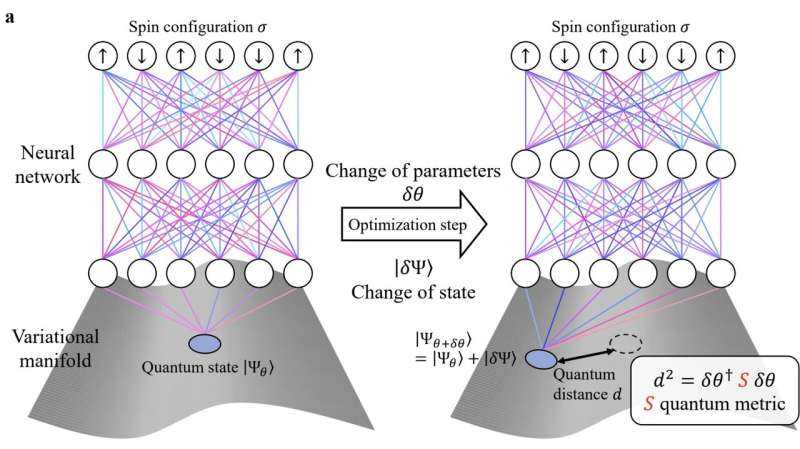July 25, 2024 feature
This article has been reviewed according to Science X's editorial process and policies. Editors have highlighted the following attributes while ensuring the content's credibility:
fact-checked
peer-reviewed publication
trusted source
proofread
Optimization algorithm successfully computes the ground state of interacting quantum matter

Over the past decades, computer scientists have developed various computing tools that could help to solve challenges in quantum physics. These include large-scale deep neural networks that can be trained to predict the ground states of quantum systems. This method is now referred to as neural quantum states (NQSs).
These computational tools essentially encode the fundamental object of a quantum system—its wavefunction—into artificial neural networks. Despite their promise, the performance of these algorithms has been limited by a lack of powerful optimization algorithms that are well-suited to train them on quantum many-body problems.
Researchers at the University of Augsburg recently introduced a new stochastic-reconfiguration optimization algorithm that can be used to train deep neural quantum networks of unprecedented size with up to 106 parameters. This algorithm, presented in a paper published in Nature Physics, was successfully used to accurately compute the ground state of a quantum spin liquid (QSL) obtained by an NQS.
"Our paper focuses on the NQS method initially proposed in 2017," Ao Chen, co-author of the paper, told Phys.org. "The community of computational quantum physics was initially excited about the idea of representing quantum states with neural networks and hoped NQS could produce novel insights into quantum many-body problems. However, people gradually realized the difficulty of making NQS better than existing methods."
The key advantage of NQSs over conventional computing approaches is their large number of artificial neuron connections. To enhance the performance of these techniques, therefore, researchers often try to further increase their size.
Past studies suggested that making NQS techniques bigger and deeper could allow them to outperform conventional approaches for conducting physics research, potentially leading to new important discoveries or insights. The recent study by Chen and his colleagues is rooted in this idea, thus the team utilized a deeper and larger NQS.
"A major bottleneck for utilizing large-scale NQS is the computational complexity in the training," Chen explained. "As one increases the number of parameters Np in the network, the computational cost scales as Np3, which is unaffordable for large networks.
"In this work, we simplify this training complexity through a surprisingly simple linear algebra identity without loss of accuracy and reduce the computational cost to proportional to Np."
The simplified training formula devised by the researchers allowed them to train an NQS with more than 1 million parameters, approximately 100 times more than those that previous approaches were trained on. The resulting NQS was found to attain remarkable results, allowing Chen and his colleagues to accurately compute a quantum spin liquid (QSL) ground state.
"In the square J1-J2 Heisenberg model, there have been many papers stating the existence of a QSL phase," Chen said. "Due to the difficulty of expressing QSL states, this system has also been viewed as the testing ground for numerical methods, where pure NQS methods didn't approach the accuracy of other methods. In this work, we show that deep NQS can greatly outperform all other methods and obtain accurate QSL states."
The recent study by Chen and his colleagues could greatly contribute to the study of interacting quantum many-body systems. Specifically, their findings highlight the promise of NQS techniques for accurately predicting the properties of these systems while also introducing an optimization algorithm that enhances NQS training.
"In the future, we want to extend our research in many different directions," Chen added. "As NQS has proved to be powerful in QSL systems, we plan to use it to study many systems that possibly reveal the features of QSL, and compare our numerical results to experiments. We also hope to apply our approach to fermionic systems and gain a deeper understanding of the behavior of electrons in condensed matter systems."
More information: Ao Chen et al, Empowering deep neural quantum states through efficient optimization, Nature Physics (2024). DOI: 10.1038/s41567-024-02566-1
Journal information: Nature Physics
© 2024 Science X Network





















